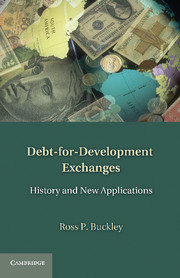Book contents
- Frontmatter
- Contents
- Acknowledgments
- List of Contributors
- Introduction: A Productive Partnership between Civil Society and the Academy
- Part I Types of Exchanges and Their Development over Time
- Part II Exchanges by Donor Countries
- Part III Critiques of Exchanges
- Part IV Innovative Applications of Exchanges
- 15 Farmer-Managed Natural Regeneration: A Land Rehabilitation Technique Well Adapted to Funding by Exchanges
- 16 Restoring Mangroves in the Philippines
- 17 Poverty Reduction through Social Protection: A Potential Form of Debt-for-Development Exchange
- 18 Climate Change Adaptation Exchanges: An Exploration of the Possibilities and Risks
- 19 Climate Change and Food Security: Building Resilience by Means of Climate Field Schools
- 20 Debt-for-Security Exchanges
- 21 Promoting Good Governance through ICT Systems: Improving Transparency and Reducing Corruption
- 22 Using Debt Exchanges to Enhance Public Accountability to Citizens
- Conclusion
- Index
- References
20 - Debt-for-Security Exchanges
Published online by Cambridge University Press: 01 June 2011
- Frontmatter
- Contents
- Acknowledgments
- List of Contributors
- Introduction: A Productive Partnership between Civil Society and the Academy
- Part I Types of Exchanges and Their Development over Time
- Part II Exchanges by Donor Countries
- Part III Critiques of Exchanges
- Part IV Innovative Applications of Exchanges
- 15 Farmer-Managed Natural Regeneration: A Land Rehabilitation Technique Well Adapted to Funding by Exchanges
- 16 Restoring Mangroves in the Philippines
- 17 Poverty Reduction through Social Protection: A Potential Form of Debt-for-Development Exchange
- 18 Climate Change Adaptation Exchanges: An Exploration of the Possibilities and Risks
- 19 Climate Change and Food Security: Building Resilience by Means of Climate Field Schools
- 20 Debt-for-Security Exchanges
- 21 Promoting Good Governance through ICT Systems: Improving Transparency and Reducing Corruption
- 22 Using Debt Exchanges to Enhance Public Accountability to Citizens
- Conclusion
- Index
- References
Summary
INTRODUCTION
The rule of law is essential to good governance and development. In the words of Alexander Downer, Australia's former Minister for Foreign Affairs, ‘Sustainable broad-based [economic] growth is impossible in countries which cannot guarantee public safety.… In violent or insecure environments, inevitably the poor pay the highest price.’
The foregoing chapters have illustrated that debt exchanges can be used to address a broad range of development goals. This chapter argues the mechanism has a largely untapped potential – to fund security-enhancing projects. Two examples are explored in this chapter: using debt exchanges to fund peace initiatives in Mindanao and nuclear nonproliferation activities.
MINDANAO
Civil conflict has being going on for five centuries in Mindanao in the Philippines, and it is now the second-oldest conflict in the world. This insecurity encourages people to join vigilante groups while discouraging them from investing in their future through agriculture, education, infrastructure and resource protection.
Conflict in Mindanao is a complex problem. It is concentrated in rural Muslim-majority communities and originated from the Moro clans' resentment of the increasing number of Christian settlers and Christian central control. The Moro National Liberation Front (MNLF) emerged in the 1960s, and Muslim resistance developed into armed conflict. More recently, the Moro Islamic Liberation Front (MILF) has also emerged. The MNLF is the government's main opponent, and the MILF is a more religiously focussed resistance group.
- Type
- Chapter
- Information
- Debt-for-Development ExchangesHistory and New Applications, pp. 247 - 259Publisher: Cambridge University PressPrint publication year: 2011

